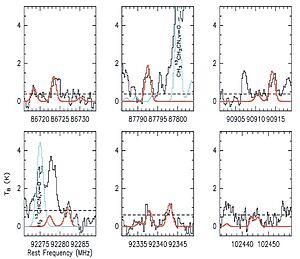1) Laboratory Astrophysics
The team explores astrophysically relevant gas-phase species, and more specifically complex organic molecules and radicals, in support of observations from ALMA or JWST to help assign unknown transitions and understand gas-phase formation paths of complex organic molecules from small reactive molecules (ions or neutrals) or radicals. Of note, spectroscopies of the planetary's atmosphere and that of the Interstellar medium by either high-resolution mmw/THz spectroscopy or radio- astronomy can bear similarity, as exemplified in this section.
a. Complex Organic (COMs) and Aromatic (PAHs) Molecules, Radicals, Ions.

One of the goals of planetary science and astrophysics is to provide answers concerning the emergence of life on Earth. Ro-vibrational molecular spectroscopy turns out to be ideally suited for these two fields as it allows us to probe the composition and physical conditions of the diffuse matter where molecules are formed, from comets and planetary atmospheres to star-forming regions and clouds, interstellar and planetary nebulae of near and distant galaxies. The complete analysis of astronomical observations requires detailed knowledge of molecular spectral properties, which can only be obtained through advanced laboratory studies.
Our team works closely with the astrophysical community on molecules which are key to the emergence of life, the so-called complex organic molecules (COMs). Their normal species and, in the case of the most abundant ones (propionitrile, methyl formate, dimethyl ether, and methanol), their isotopic variants have been spectroscopically investigated. Such a work is of primary importance because it provides us with essential information for refining astrochemistry models. Although most models are consistent with COMs formation taking place mostly on the grain surface in prestellar and protostellar cores, many reaction pathways are still unknown. The main motivation behind this project is to obtain new data to understand the formation process of COMs; it also aims at cleaning astrophysical spectra surveys prior to detecting new molecular species. Recently the need for improving the astrochemistry models has been further exacerbated by the detection of various molecules in dark, cold clouds for which standard gas phase chemistry and grain surface chemistry fail to explain the observed abundances. The recently online Lille Spectroscopic Database (lsd.univ-lille.fr) is already used by astrophysics groups (Grenoble, Bonn, Madrid, MIT).
We can cite the detection of propionamide, a peptide-like molecule, in Sgr B2(N) cloud and the spectroscopy of Radicals (unstable species like CH2OH, CH3CO+) related to the chemistry of the interstellar medium done in the context of international collaborations (USA, Spain, Japan).
c. High-resolution spectroscopy of methane and ammonia
The team is interested in methane and ammonia for the spectroscopic databases, where the lack of data is compensated by the team’s expertise in high-resolution laser absorption spectroscopy or Fourier Transform Spectroscopy (via collaborations with Grenoble, Brussels, Bratislava (Peter Cermak), and Prague (Ondrej Votava)).
With the help of existing ab initio calculations (UCL and JPL groups), the team developed specific skills to unambiguously assign high-resolution spectra, which is essential for predicting the spectrum of a molecule under various temperature and pressure conditions. These collaborations have helped fill the gap in data in the near-infrared energy ranges (3900 to 7000 cm⁻¹).

